|
Dromaeosauridae |
These small to medium-sized predators were made famous
by the movie Jurassic Park,
Of course great entertainment value demanded that the movie velociraptors
be much larger and smarter than the real thing. The movie
monsters were shown about three times larger than the real thing and
velociraptors were certainly not smart enough nor dexterous enough to
turn a doorknob.
All dromaeosaurs did have a pair of
retractable
sickle-shaped claws on their inside toes (the second toe
officially, counting from the inside of the foot outwards). They were
held off the ground to keep them sharp, and were probably never
clicked against the ground, as seen in the kitchen scene in
Jurassic Park. However a dromaeosaur's main weapons were the sharp
slashing claws on its hands, which along with the teeth probably did
most of the damage to prey. The foot claws were probably used for
gripping onto the backs of large prey, and to deliver the final fatal
blows between the ribs or across the stomach. Their curvature is also
reminiscent of the beaks of modern predatory birds (true raptors), so
perhaps the foot claws were used to tear pieces out of a carcass.
The dromaeosaurs are a group of fascinating
creatures. They are commonly referred to as the "raptors," but
this is not a technical term favored by scientists to describe these
predatory dinosaurs as the scientific term refers to modern day birds
of prey, which include the eagles and hawks. Scientists refer to
the dinosaurs by the name of the clade, which is Dromaeosauridae, or
the term "Dromaeosaurs."
Dromaeosaurs are a small
clade of theropod dinosaurs which exhibit some highly derived
characteristics that they all share. They had excellent eyesight
that permitted them to see distant prey. They ran on legs and
had a stiffened tail that probably functioned as a dynamic stabilizer.
They were fast and agile. They had large grasping manus (hands), with
a well-developed slashing talon on their second pedal phalanx (toe).
They had muscular and toothy jaws and large brains for their size.
In short, there were smart, quick and very lethal killing machines.
The dromaeosaurs were the most birdlike of all dinosaurs. Of
special interest is their forelimbs, which permitted highly flexible
seizing, great for grabbing prey. It was this ability which may
have made possible the "flight stroke." Feathers are so fragile
that they very rarely ever fossilize. The discovery of
Microraptor in 2000 was a major milestone in determining the
relationship between dinosaurs and birds. The little fellow was
covered with feathers and is considered the American version of
Archaeopteryx. Although feathers have not been found on later
dromaeosaurs, scientists are confident that they had them, as they
descended from Microraptor. Many believe that modern birds and
Dromaeosaurs shared a common ancestor sometime in the
Jurassic period; Dromaeosauridae is thus termed the sister group of
the clade Aves (birds). It may even be that the
ancestry of birds lies within this group, which would make them
dromaeosaurs too, but this has not yet been established.
Numerous unnamed and indeterminate dromaeosaurids are known.
A few other species are named below. |
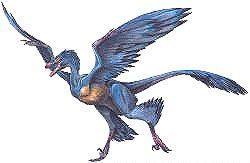 |
Microraptor gui
- 126
MYA
China - 16 inches long
This exquisite little fellow was covered with feathers and has been
called one of the most-bird like dinosaurs ever known. Many
paleontologists believe it may play a key role in proving once and
for all that birds evolved from small meat-eating dinosaurs. |
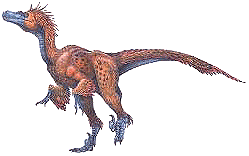 |
Deinonychus antirrhopus
- 120 MYA
Montana, USA. 10 feet long.
Deinonychus was a fast and vicious hunter. Its name means
"terrible claw," and it was given this name because of the large,
retractable hunting claw on each of its feet. Like its cousin, the
Velociraptor, it used this claw to tear into the flesh of the
dinosaurs it hunted. |
|
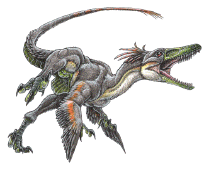 |
Buitreraptor gonzalezorum
- 90 MYA
Argentina. 2 feet long
This 2005 discovery in the Southern Hemisphere confirms that
dinosaurs were more widely dispersed around the world than
previously thought. Scientists now think that dromaeosaurs date
back to Jurassic times, when all the continents were much closer
together. It is possible that they originated on the ancient
continent Laurasia in the north, and migrated to southern Gondwana
later.
|
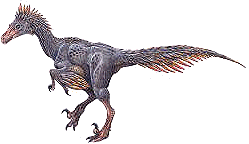 |
Unenlagia comahuensis -
90 MYA
Argentina 10 feet long.
Unenlagia is
the most bird-like dinosaur found so far - it even had arms that
were designed so they could flap like a bird's wings! However,
this dinosaur was much too large to fly, but it clearly shows how
some dinosaurs were evolving to look and act like modern birds.
|
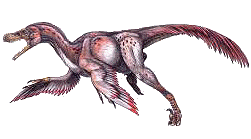 |
Bambiraptor feinbergorum - 80 MYA
Montana, USA. 3 feet long.
Bambiraptor is one of the most important
fossils found in North America. This little bird-like dinosaur was
a very quick hunter, and it may have been an important step in
dinosaurs' evolution into birds. Bambiraptor is considered by many to be the North American
version of
Archaeopteryx. |
|
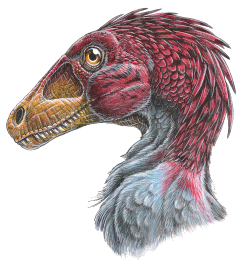 |
Atrociraptor marshalli
This is a dromaeosaurid dinosaur species
from the Upper Cretaceous of Alberta, Canada. The type (and only)
specimen was discovered in the Horseshoe Canyon Formation, near
Drumheller, Alberta. It had a relatively short, massive skull with
slender lower jaws and long, highly curved teeth (the rest of the
skeleton is unknown). |
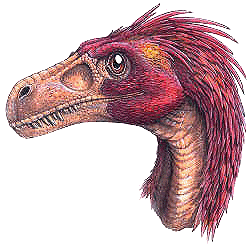 |
Dromaeosaurus
albertensis - 70 MYA
Alberta, Canada. 6 feet long
Dromaeosaurus was the original raptor. It was a small, vicious
hunter that had a mouth full of serrated, razor-sharp teeth and a
sharp, hooked claw on each foot that it used to clamp down on its
victims. The first and only good Dromaeosaurus remains
were found by Barnum Brown on the south bank of the Red Deer River
in 1914. |
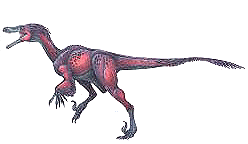 |
Velociraptor
mongoliensis - 67 MYA
Mongolia, China. 6 feet long
Velociraptor was made famous by the movie "Jurassic Park."
However the movie dinosaur was greatly exaggerated. The
real Velociraptor was much smaller than shown in the
film and was smart enough nor dexterous enough to open doors.
Still, pound for pound, Velociraptor was a very effective
killing machine! |
|
|
Other Species |
|
|
Dromaeosaurs have been recently
found in Argentina, Denmark, and other places. Some were
about the size of the
Jurassic Park villains, and some were even larger! |
|
|
Achillobator giganticus (Perle, Norell, and Clark, 1999)
Means "Achilles Hero" Pronounced:
"a-Kill-o-ba-tor"
Length: 17 ft. (5 meters)
Weight: unknown
Mongolia, China. Late Cretaceous - 85 MYA
Achillobator was a giant raptor dinosaur that
was discovered in 1999 and scientists are still studying this
huge meat-eater. This dinosaur was similar in size to the North
American Utahraptor and was probably one of the most
vicious hunters of its time. It has made scientists rethink their
ideas about the raptor family in Asia. Known from a
maxilla, hindlimbs, pelvis, and caudals, it has a variety of
unusual features for a dromaeosaurid, including pubes with their
front ends lengthened and deep upper jaws. It has been suggested
that this animal was close to Dromaeosaurus
Further study is needed to firmly assign Achillobator
to the
dromaeosaur family. Its initial assignment to this group
is based on a number of shared characteristics, but these findings
are preliminary. |
|
|
Adasaurus mongoliensis (Barsbold, 1983)
Means: "Ada Lizard" Pronounced: "A-dah-Sore-us"
Length: 6 feet (2 m).
Weight: 33 pounds (15 kilos)
Mongolia, China. Late Cretaceous
- 75 MYA
Adasaurus was a small, meat-eating dinosaur that was very
lightweight and had many bird-like features. It is considered to
be the closest non-avian relatives of the Archaeopteryx.It is based on a partial skeleton of an old
individual that includes both a pelvis with the bird condition
(pubis pointing backward) and a foot with a hyperextendable second
claw (albeit probably less powerful than the "killer claw" of most
dromaeosaurids). Scientists believe that it had feathers.
This small dinosaur adds fuel to the ever-growing debate
surrounding dinosaurs and birds. Adasaurus has been
described as being extremely similar to Archaeopteryx. It has
enough of the dromaeosaur characteristics to be placed in
that family too, but the overall view of those types of raptors is
evolving into their being referred to as bird-like dinosaurs,
complete with feathers. Eventually, some members of the family may
be reclassified as birds instead of dinosaurs. |
|
|
Atrociraptor marshalli (Currie and Varricchio, 2004)
Means "Savage Raptor."
Discovered in 2004 and described in the book, Feathered Dragons.
It had a relatively short, massive skull with slender lower
jaws and long, highly curved teeth (the rest of the skeleton is
unknown). Similar teeth are found in the Upper Cretaceous
Lance Formation. Atrociraptor
seems to be most similar to
Deinonychus. |
|
|
Dromaeosauroides bornholmensis
(Christiansen and Bonde, 2003)
ate Berriasian-Valanginian (EK) of Denmark
Denmark's first named classic dinosaur is a dromaeosaurid based on
a tooth, thought to be close to Dromaeosaurus itself (hence
the name). |
|
|
Neuquenraptor argentinus
(Novas and Pol, 2005)
Perhaps you knew this as "Araucanoraptor argentinus",
possible
troodontid. Put all of the material together, and you get a
good chunk of hindlimb (including the all-important foot), part of
a cervical, ribs, and a partial radius. It adds up to a basal
dromaeosaurid that teams up with Unenlagia to hint at a
hitherto-unappreciated deinonychosaurian radiation in Gondwana,
and also illustrates that arctomets were useful to a variety of
coelurosaurians, but quite a bit more complicated for people
trying to understand their evolution (it has the famous arctomet,
which is why it was first identified as a troodontid). |
|
|
Nuthetes destructor (N.D.)
Owen, 1854
early Berriasian (EK) of England
This taxon from the early days of dinosaur paleo is still very
much a mystery. It has been at times considered a lizard or a
juvenile "megalosaur".
Originally referred to it were ?armor scutes which have been
reassigned to the somewhat better known
ornithischian Echinodon. The remains left behind,
particularly the type, a dentary fragment with teeth, appear to
pertain to a dromaeosaurid. |
|
|
Pyroraptor olympius -
(Allain and Taquet, 2000)
Name Means: "Fire Raider"
Pronounced: Pie-row-Rap-tore
Length: unknown (small).
Weight: unknown
France. Late Cretaceous - 76 MYA
Pyroraptor is the first positively identified
member of the raptor family found in Europe. This was a small,
fast hunter that lived near the end of the age of dinosaurs. The
specimen is known from only a few bones, but they included the
"killer claw" associated with this group. They were enough to give
scientists a good idea of what this little dinosaur would have
looked like. Some paleontologists believe it would have closely
resembled the small, bird-like dinosaurs recently discovered in
China. Pyroraptor earned its name because the type
material was discovered after a forest fire. It is based on a
with additional remains referred to it. |
|
|
Rapator ornitholestoides
(von
Huene in 1932)
Australia. Very little information.
Based on a single hand bone from Victoria, Australia, Rapator
is a large dinosaur from the middle Cretaceous that has
puzzled researchers for decades. |
|
|
Saurornitholestes langstoni
(Sues, 1978)
late Campanian (LK) of Alberta, ?early Maastrichtian (LK) of New
Mexico Saurornitholestes appears in some ways to be
between Velociraptor and Deinonychus in
anatomy. It was initially classified as a "saurornithoidid" (troodontid).
Its name gets tossed around a lot, but it's in bad need of
revision. |
|
|
Utahraptor kirklandi:
During the filming of the movie Jurassic Park,
fragments of a large dromaeosaur skeleton were found in Utah. A
study proclaimed that the giant raptor from the movie had been
found; this animal seemed to be the perfect size for such a
creature. |
|
|
Utahraptor ostrommaysorum (Kirkland, Gaston, and Burge, 1993)
Barremian (EK) of Utah
A contemporary of the large
polacanthid Gastonia, Utahraptor is the
largest known official dromaeosaurid. Several individuals are
known from partial remains, but the taxon as a whole is not yet
particularly well known. It may have been close to the large
Mongolian dromaeosaurid Achillobator, but is not really all
that well known yet. |
|
|
Utahraptor oweni
Means: "Utah Robber" Pronounced: "U-taw-Rap-tor"
Length: 23 feet (7 m).
Weight: 1 ton (900 kilos)
Utah, USA. Cretaceous
When the movie "Jurassic Park" was released, dinosaur fans
everywhere complained that director Steven Spielberg had made his
movie Velociraptors much larger than they were in real life. In
the midst of this controversy, Dr. James Kirkland and paleontology
student Rob Gaston unearthed the real-life giant raptor that was
shown in the movie - only bigger! Utahraptor was huge, and
with its big killing claws, strong arms and hands, and sharp
teeth, it was one of the most ferocious killers on the planet.
One of the most unique aspects that Utahraptor shares
with its more famous cousin Velociraptor is that both had a
lethal killing claw on each foot. Each inside toe had a large
(about 10 inches) hooked claw that was controlled by a strong
tendon. This claw was held upward when the animal was walking or
running. When it attacked, however, the tendon snapped tight and
the claw clamped down with great speed and force, slicing deeply
into its victim. Not a very pretty picture, but an effective way
to inflict a serious wound.
Utahraptor is the oldest known, and largest, of the
dromaeosaurids. This is interesting as it points to a family that
shrunk over time. Its hand claws were proportionally larger than
other family members and Dr. Kirkland speculates that its hand
claws were probably as important a weapon as the killing claws on
its feet. Utahraptor is the subject of a best-selling book
by Dr. Robert Bakker. Entitled "Raptor Red," it is currently being
developed into a motion picture. |
|
|
|
|
|
|
|
|
Edugraphics.Net | Feenixx Publishing |
|
|
|
|
|
![]()







